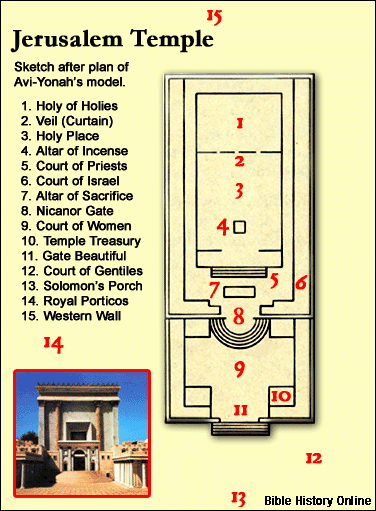Schematic Plan of the Temple

Unraveling the Mysteries of Herod's Temple: A Schematic Plan
The grandeur of ancient civilizations never ceases to amaze us, and one of the most iconic structures of antiquity is undoubtedly the Herod's Temple, also known as the Second Temple. Erected during the reign of King Herod the Great, this architectural marvel stood as the center of religious and cultural life in ancient Jerusalem. Let's embark on a journey to explore the schematic plan of this historical wonder.
Historical Context:
The Second Temple, constructed on the site of the original Temple of Solomon, became a focal point for Judaism after the Babylonian destruction of the First Temple in 586 BCE. King Herod, known for his ambitious building projects, sought to refurbish and expand the Second Temple, transforming it into a structure that would rival the grandest buildings of his time.
The Temple Mount:
Herod's Temple was situated atop the Temple Mount, a vast elevated platform in the heart of Jerusalem. This sacred platform covers an area of approximately 35 acres and is revered as one of the most sacred sites in Judaism, Christianity, and Islam.
The Courtyards:
The Temple complex consisted of several courtyards, each with its specific purpose and significance. The outermost court was the Court of the Gentiles, open to people of all backgrounds, acting as a place of gathering and commerce. Moving inward, the Court of the Women was accessible to Jewish women and served as a worship space for female worshipers.
The Inner Sanctuary:
Advancing further, we reach the innermost courtyards where the core of the temple was located. The Court of Israel was accessible to Jewish men, and beyond this stood the Court of Priests, accessible only to the priestly caste. At the center of it all was the Holy of Holies, the most sacred chamber, where the Ark of the Covenant was believed to have been placed in the First Temple.
The Temple Structure:
The main structure of the Second Temple was an impressive edifice, featuring majestic columns, intricate carvings, and lavish decorations. The layout was aligned with strict religious specifications and had several sections:
- The Porch (Ulum): A grand entrance hall with imposing columns leading to the main sanctuary.
- The Holy Place (Hekal): A vast hall where priests conducted daily rituals and maintained the menorah (seven-branched candelabrum).
- The Holy of Holies (Debir): This inner sanctum was accessible only by the High Priest once a year, during the sacred Yom Kippur, and housed the Ark of the Covenant in earlier iterations.
Herod's Architectural Masterpiece:
King Herod's vision for the Second Temple surpassed all expectations. His architects employed cutting-edge engineering techniques and innovative designs. The use of massive stones, some weighing over 100 tons, displayed the ingenuity and prowess of ancient construction.
Legacy and Destruction:
The completion of Herod's Temple was a momentous occasion for the Jewish people, signifying a revival of their religious and cultural heritage. However, this remarkable monument was not destined to stand the test of time. In 70 CE, the temple faced utter devastation at the hands of the Roman Empire during the First Jewish-Roman War, leaving only the Western Wall (Wailing Wall) as a poignant remnant of its former glory.
Contemporary Significance:
Despite its destruction, Herod's Temple continues to captivate historians, archaeologists, and the faithful alike. The schematic plan of this iconic structure not only reveals the meticulous attention to detail in its construction but also serves as a testament to the enduring cultural and spiritual significance it holds for people of various beliefs.
In conclusion, Herod's Temple remains an awe-inspiring testament to the architectural and religious brilliance of ancient civilizations. As we explore its schematic plan, we uncover the depth of human ingenuity and the enduring legacy of this remarkable historical marvel.
Read The Bible
- 1599 Geneva Bible (GNV)
- 21st Century King James Version (KJ21)
- American Standard Version (ASV)
- Amplified Bible (AMP)
- Amplified Bible, Classic Edition (AMPC)
- Authorized (King James) Version (AKJV)
- BRG Bible (BRG)
- Christian Standard Bible (CSB)
- Common English Bible (CEB)
- Complete Jewish Bible (CJB)
- Contemporary English Version (CEV)
- Darby Translation (DARBY)
- Disciples’ Literal New Testament (DLNT)
- Douay-Rheims 1899 American Edition (DRA)
- Easy-to-Read Version (ERV)
- English Standard Version (ESV)
- English Standard Version Anglicised (ESVUK)
- Evangelical Heritage Version (EHV)
- Expanded Bible (EXB)
- GOD’S WORD Translation (GW)
- Good News Translation (GNT)
- Holman Christian Standard Bible (HCSB)
- International Children’s Bible (ICB)
- International Standard Version (ISV)
- J.B. Phillips New Testament (PHILLIPS)
- Jubilee Bible 2000 (JUB)
- King James Version (KJV)
- Lexham English Bible (LEB)
- Living Bible (TLB)
- Modern English Version (MEV)
- Mounce Reverse Interlinear New Testament (MOUNCE)
- Names of God Bible (NOG)
- New American Bible (Revised Edition) (NABRE)
- New American Standard Bible (NASB)
- New American Standard Bible 1995 (NASB1995)
- New Catholic Bible (NCB)
- New Century Version (NCV)
- New English Translation (NET)
- New International Reader's Version (NIRV)
- New International Version - UK (NIVUK)
- New International Version (NIV)
- New King James Version (NKJV)
- New Life Version (NLV)
- New Living Translation (NLT)
- New Matthew Bible (NMB)
- New Revised Standard Version (NRSV)
- New Revised Standard Version Catholic Edition (NRSVCE)
- New Revised Standard Version, Anglicised (NRSVA)
- New Revised Standard Version, Anglicised Catholic Edition (NRSVACE)
- New Testament for Everyone (NTE)
- Orthodox Jewish Bible (OJB)
- Revised Geneva Translation (RGT)
- Revised Standard Version (RSV)
- Revised Standard Version Catholic Edition (RSVCE)
- The Message (MSG)
- The Voice (VOICE)
- Tree of Life Version (TLV)
- World English Bible (WEB)
- Worldwide English (New Testament) (WE)
- Wycliffe Bible (WYC)
- Young's Literal Translation (YLT)
Table of Contents

- Herod's Temple
- Introduction
- Overview
- The Site
- Solomon's Temple
- Zerubbabel's Temple
- Rebuilding the Temple
- Golden Gate
- Court of the Gentiles
- Solomon's Porticoes
- Antonia Fortress
- Inner Courts
- Women's Court
- Court of Israel
- Court of the Priest's
- Altar of Sacrifice
- Holy Place
- Holy of Holies
- Jesus and the Temple
- Archaeology
- Historical Writings
- Scriptures
- Dictionaries
- Encyclopedias
- Conclusion
Main Menu
- Ancient Assyrian Social Structure
- Ancient Babylonia
- Ancient Canaan During the Time of Joshua
- Ancient History Timeline
- Ancient Oil Lamps
- Antonia Fortress
- Archaeology of Ancient Assyria
- Assyria and Bible Prophecy
- Augustus Caesar
- Background Bible Study
- Bible
- Biblical Geography
- Fallen Empires - Archaeological Discoveries and the Bible
- First Century Jerusalem
- Glossary of Latin Words
- Herod Agrippa I
- Herod Antipas
- Herod the Great
- Herod's Temple
- High Priest's in New Testament Times
- Jewish Literature in New Testament Times
- Library collection
- Map of David's Kingdom
- Map of the Divided Kingdom - Israel and Judah
- Map of the Ministry of Jesus
- Matthew Henry Bible Commentary
- Messianic Prophecy
- Nero Caesar Emperor
- Online Bible Maps
- Paul's First Missionary Journey
- Paul's Second Missionary Journey
- Paul's Third Missionary Journey
- Pontius Pilate
- Questions About the Ancient World
- Tabernacle of Ancient Israel
- Tax Collectors in New Testament Times
- The Babylonian Captivity
- The Black Obelisk of Shalmaneser
- The Books of the New Testament
- The Court of the Gentiles
- The Court of the Women in the Temple
- The Destruction of Israel
- The Fall of Judah with Map
- The History Of Rome
- The Incredible Bible
- The Jewish Calendar in Ancient Hebrew History
- The Life of Jesus in Chronological Order
- The Life of Jesus in Harmony
- The Names of God
- The New Testament
- The Old Testament
- The Passion of the Christ
- The Pharisees
- The Sacred Year of Israel in New Testament Times
- The Samaritans
- The Scribes
Ancient Questions
- Why Do the Huldah Gates Appear Different in Ancient Replicas and Modern Photos?
- What Is the Origin of the Japanese and Chinese Peoples? A Biblical Perspective
- How did the ancient Greeks and Romans practice medicine and treat illnesses?
- What were the major contributions of ancient Babylon to mathematics and astronomy?
- How did the ancient Persians create and administer their vast empire?
- What were the cultural and artistic achievements of ancient India, particularly during the Gupta Empire?
- How did ancient civilizations like the Incas and Aztecs build their remarkable cities and structures?
- What were the major trade routes and trading practices of the ancient world?
- What was the role of slavery in ancient societies like Rome and Greece?
- How did the ancient Mayans develop their sophisticated calendar system?
Bible Study Questions
- Why Do Christians Celebrate Christmas?
- How Many Chapters Are There in the Bible?
- The Five Key Visions in the New Testament
- The 400-Year Prophecy: Unpacking Genesis 15 and the Journey of a People
- The Authorized (King James) Version (AKJV): Historical Significance, Translation Methodology, and Lasting Impact
- Exploring the English Standard Version (ESV): Its Aspects, Comparisons, Impact on Biblical Studies, and Church Use
- A Detailed Historical Analysis of Language Updates in the KJ21: Comparison with Other Versions
- A Detailed Historical Analysis of the American Standard Version (ASV): Comparison to the King James Version, Influence on Later Translations, and Evaluation of Strengths and Weaknesses
- A Detailed Historical Analysis of Amplifications in the Amplified Bible (AMP) and Its Comparison to Other Bible Translations
- Detailed Historical Analysis of the Amplified Bible Classic Edition (AMPC): Examples of Amplifications and Comparative Analysis with Other Bible Translations
About
Welcome to Free Bible: Unearthing the Past, Illuminating the Present! Step into a world where ancient history and biblical narratives intertwine, inviting you to explore the rich tapestry of human civilization.
Discover the captivating stories of forgotten empires, delve into the customs and cultures of our ancestors, and witness the remarkable findings unearthed by dedicated archaeologists.
Immerse yourself in a treasure trove of knowledge, where the past comes alive and illuminates our understanding of the present.
Join us on this extraordinary journey through time, where curiosity is rewarded and ancient mysteries await your exploration.
Recent posts
-

Why Discipleship Ministries Matter: How They Shape Churches and Communities
Discipleship ministries have traditionally played an important role in Christians' spiritual growth and the long-term viability of their churches. Chr... -

A Historical Journey of Health Insurance: From Ancient Mutual Aid to Modern Coverage
The modern form of health insurance, which is premium based, pooled risk financial coverage during illness is a relatively new development. But the th... -

Get a Crypto License in Poland - Secure, EU-Ready, and Backed by Prifinance Expertise
Expand your crypto business legally in the European Union with a crypto license in Poland under the MiCA framework. Poland has become one of the most ... -

Why Partnering with the Right Mobile App Development Company Can Make or Break Your Project
Why Partnering with the Right Mobile App Development Company Can Make or Break Your Project In today's hyperconnected world, your app is frequently yo... -

Lion Posters & Canvas Wall Art — The Complete Buyer’s & Styling Guide
Collection Spotlight Lion Posters — Wild, Regal Wall Art for Every Interior A single lion portrait can command a room. A pair of lions can change th...